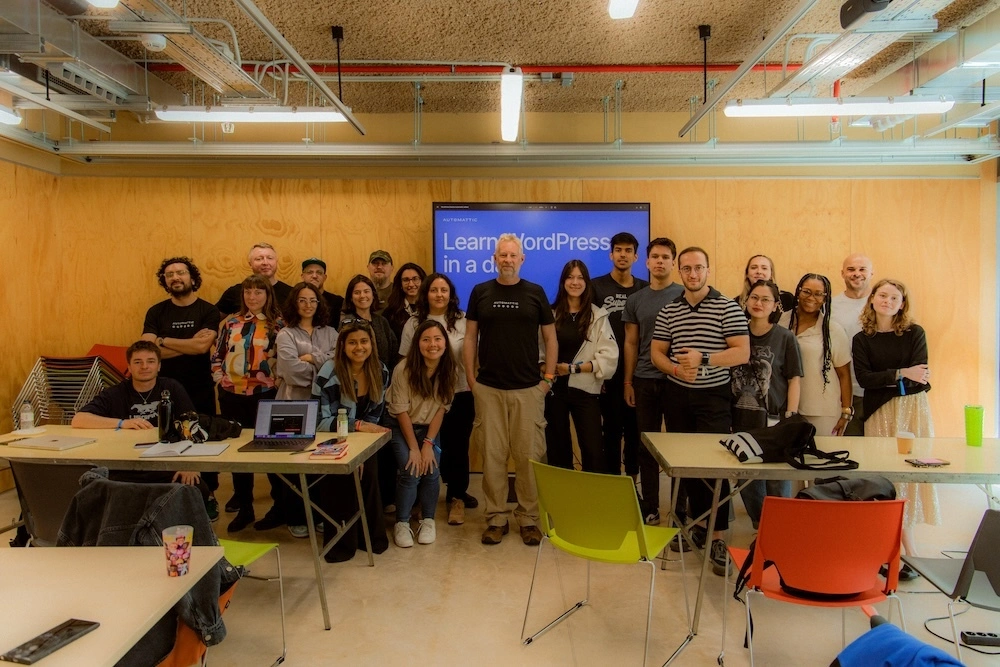
Just finished teaching a WordPress course at OFFF Barcelona with an amazing group of young, energised creatives.
They had no idea what was possible with WordPress — and they care deeply about creativity, freedom, and open source.
The workshop sold out a week before the event, with all 25 places gone and over 30 people on the waitlist. The level of interest—and the thoughtful conversations that followed—made it clear that there’s a gap between what WordPress can do today, and what many students and creatives think it can do.
It got me thinking: how can we bring that curiosity and enthusiasm into universities? And how do we scale WordPress education in a way that feels modern, relevant, and aligned with where the web is heading—especially now that AI is changing the game?
Below are some practical and forward-thinking ideas I’ve been exploring. I’d love your input—whether you’re an educator, a developer, a student, or just someone who cares about the future of open tools and digital creativity.
1. Rethink the Curriculum: WordPress + AI
It’s time to move beyond “how to install a theme” and teach how to build smart sites. Imagine a course titled:
“Building Smart Sites: WordPress + AI”
In it, students could learn:
- How to use WordPress as a no-code/low-code platform
- GPT plugins for automated content creation
- AI tools for SEO, metadata, and structured data
- How to integrate AI chatbots into websites
- Ethical considerations of AI-generated content
The goal? Equip students with tools they’ll actually use—and push them to think critically about AI’s role in digital publishing.
2. Make It Project-Based
Students should leave with more than grades—they should leave with real projects.
- Build sites for local charities, uni societies, or startups
- Use real-world client briefs (even AI-generated ones)
- Incorporate AI-driven workflows: scraping → summarizing → publishing
Each student ends up with a working portfolio site built on WordPress, powered by AI, and ready to show employers.
3. Stackable Credentials, Not Just Degrees
Universities are great at degrees—but the market is demanding micro-skills.
Why not offer bite-sized accreditations?
- WordPress Developer Basics
- AI Workflows for Digital Publishing
- WooCommerce + Automation
Stackable badges that can be added to LinkedIn and portfolios give students proof they can ship real-world solutions.
4. Scale Through a WordPress-Based Learning Platform
Let’s eat our own dog food. A WordPress-based learning system could:
- Host modular content
- Be licensed or shared with universities
- Include starter themes, assignment templates, and AI tools
Think of it as a “course in a box” that universities can plug straight into their media, design, or computing degrees.
5. Build a Shadow Curriculum on YouTube
Students don’t always learn in the classroom. Many learn on TikTok, YouTube, and Discord.
A modular YouTube-first strategy could teach in-demand skills at the pace students want—then link back to formal uni courses or bootcamps.
It’s flexible. It’s scalable. And it’s where students already are.
6. Train the Trainers
Many lecturers haven’t built a WordPress site in years—let alone with AI in the mix.
Offer a short “Train the Trainers” bootcamp:
- How to teach modern WordPress workflows
- How AI is reshaping the ecosystem
- Ready-made lesson plans and assignments
Make it dead simple for educators to integrate these ideas into their existing curriculum.
7. Use AI to Supercharge Student Learning
AI isn’t just a subject to be taught—it’s a teaching assistant in itself.
- Simulate real-world client briefs with GPT
- Use AI to give students feedback on code or content
- Help them build their own AI-powered publishing tools
You could even integrate a GPT code assistant into their local dev environment to help explain WordPress functions and debug issues in real-time.
8. Automate Workflows with WordPress + n8n + Firecrawl
Students can learn to build automated workflows, like:
- Scraping useful content with Firecrawl
- Summarising it with GPT
- Auto-publishing to WordPress with n8n
This teaches not just WordPress skills, but also how modern content ecosystems operate—with smart automation behind the scenes.
9. Partner with WordPress.org or Agencies
Collaboration is key. Universities don’t have to do this alone.
- Partner with agencies to provide live briefs
- Collaborate with the WordPress.org education team
- Let students contribute to WordPress itself (code, docs, design) for credit
Let’s turn contribution into curriculum.
Final Thoughts
Scaling WordPress education in universities isn’t just about teaching software. It’s about showing students how to build things that matter—fast, smart, and with tools that reflect the future of the web.
AI isn’t a threat to education. It’s the lever that can make learning more relevant, responsive, and real.
Leave a Reply